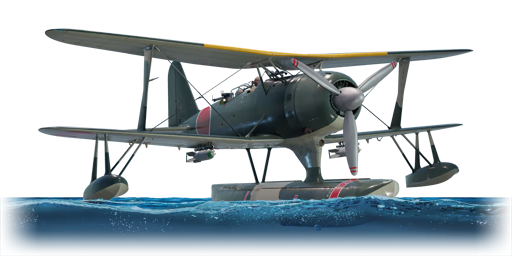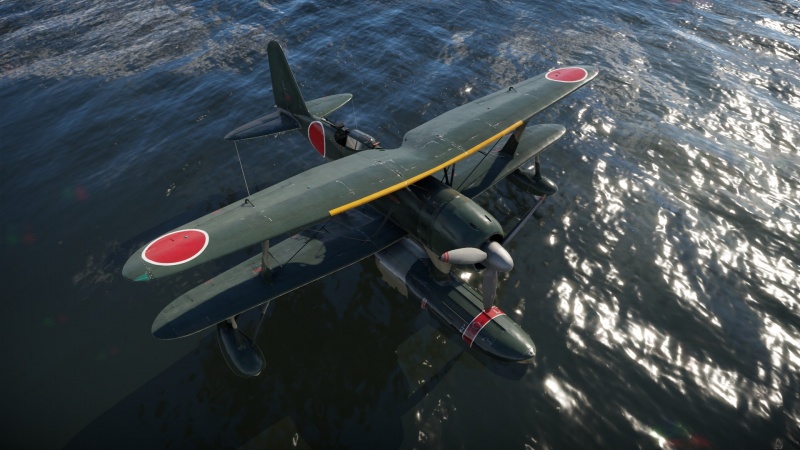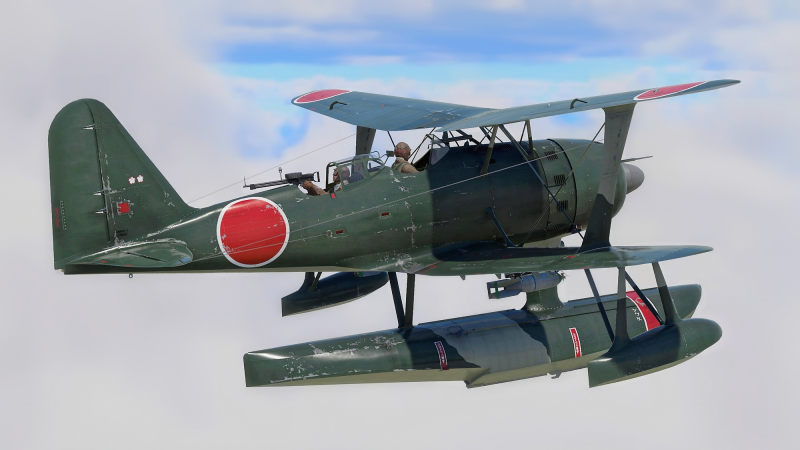Difference between revisions of "F1M2"
Lucid_Oven (talk | contribs) m (→See also) (Tag: Visual edit) |
Colok76286 (talk | contribs) |
||
| Line 184: | Line 184: | ||
;Skins | ;Skins | ||
| − | |||
* [https://live.warthunder.com/feed/camouflages/?vehicleCountry=japan&vehicleType=aircraft&vehicleClass=bomber&vehicle=f1m2 Skins and camouflages for the {{PAGENAME}} from live.warthunder.com.] | * [https://live.warthunder.com/feed/camouflages/?vehicleCountry=japan&vehicleType=aircraft&vehicleClass=bomber&vehicle=f1m2 Skins and camouflages for the {{PAGENAME}} from live.warthunder.com.] | ||
== See also == | == See also == | ||
| − | + | ''Links to the articles on the War Thunder Wiki that you think will be useful for the reader, for example:'' | |
| − | + | * ''reference to the series of the aircraft;'' | |
| − | * | + | * ''links to approximate analogues of other nations and research trees.'' |
== External links == | == External links == | ||
''Paste links to sources and external resources, such as:'' | ''Paste links to sources and external resources, such as:'' | ||
| − | + | * ''topic on the official game forum;'' | |
| − | * | + | * ''other literature.'' |
| − | * | ||
{{AirManufacturer Mitsubishi}} | {{AirManufacturer Mitsubishi}} | ||
{{Japan bombers}} | {{Japan bombers}} | ||
Revision as of 16:39, 2 February 2022
Contents
Description
The F1M2 is a rank I Japanese hydroplane bomber with a battle rating of 1.0 (AB/RB/SB). It has been in the game since the start of the Open Beta Test prior to Update 1.27. The Allied codename for this aircraft was "Pete".
General info
Flight performance
| Characteristics | Max Speed (km/h at 4,000 m) |
Max altitude (metres) |
Turn time (seconds) |
Rate of climb (metres/second) |
Take-off run (metres) | |||
|---|---|---|---|---|---|---|---|---|
| AB | RB | AB | RB | AB | RB | |||
| Stock | 397 | 388 | 9200 | 17.8 | 18.4 | 11.0 | 11.0 | 300 |
| Upgraded | 426 | 412 | 16.3 | 17.0 | 16.9 | 13.6 | ||
Details
| Features | ||||
|---|---|---|---|---|
| Combat flaps | Take-off flaps | Landing flaps | Air brakes | Arrestor gear |
| ✓ | ✓ | ✓ | X | X |
| Limits | ||||||
|---|---|---|---|---|---|---|
| Wings (km/h) | Gear (km/h) | Flaps (km/h) | Max Static G | |||
| Combat | Take-off | Landing | + | - | ||
| 550 | 450 | 356 | 337 | 240 | ~10 | ~7 |
| Optimal velocities (km/h) | |||
|---|---|---|---|
| Ailerons | Rudder | Elevators | Radiator |
| < 280 | < 320 | < 320 | > 313 |
Survivability and armour
The F1M2 lacks protective armour, however, its fuel tanks are self-sealing. There is one below the pilot and three behind the engine which are arranged side by side. The gunner subsequently is also not protected by any armour and can be hit easily.
Modifications and economy
Armaments
Offensive armament
The F1M2 is armed with:
- 2 x 7.7 mm Type 97 navy machine guns, nose-mounted (500 rpg = 1,000 total)
Suspended armament
The F1M2 can be outfitted with the following ordnance:
- Without load
- 2 x 60 kg Navy Type 97 Number 6 bombs (120 kg total)
Defensive armament
The F1M2 is defended by:
- 1 x 7.7 mm Type 92 machine gun, dorsal turret (582 rpg)
Usage in battles
The F1M2 is quite an interesting little biplane, and has several perks that allow it to fulfil a multitude of roles. It has surprisingly good manoeuvrability, decent armament, as well as the ability to land on water due to its floatplane design. All in all, it is a fun aircraft to fly in both air and naval battles.
Air battles:
The F1M2 would seem to be a relatively bad fighter, given that it has massive floats. However, the opposite is actually true. The F1M2 is very capable as a fighter, and has very impressive manoeuvrability for an aircraft of its type. However, be aware that the large, heavy floats result in a worse turning circle than most dedicated biplane fighters such as the I-15, He-51 or Fury. Though the F1M2 is still an able turner and can keep up with some fighters such as the P-26, pursuing a direct fighter engagement is not advised as it is generally a bit worse than dedicated fighter aircraft. As well, the F1M2 is rather slow, so don't expect it to outrun anything (other than extremely slow aircraft like the Po-2 or Swordfish, of course).
The F1M2 is equipped with two 7.7 mm Type 97 machine guns which are quite adequate for tearing biplanes apart. However, these guns are relatively bad for everything else, and won't do much damage to aircraft built out of metal. Of course, most aircraft at its BR are wooden biplanes, so the weapon is quite adequate. As well, the F1M2 can carry two 60 kg bombs, which are more than enough to destroy any lightly-armoured targets. Finally, the F1M2 has an ace up its sleeve - the 7.7 mm defensive gun. This weapon is mounted on a flexible mounting at the rear, and is a potent anti-aircraft weapon. In general, due to its lack of powerful guns or suspended ordnance, the F1M2 should be played more as a "heavy" fighter, utilizing its great manoeuvrability, airspawn, and defensive armament.
Naval battles:
Naval battles are the area where the F1M2 shines. Due to its floatplane design, it can easily cap bases by landing on them. When flying in this capacity, beware of any PT boats in the nearby area, and never land when there are enemy vessels close by. Though most ships at its BR have little to no heavy armament, they are still very capable of shredding a plane sitting on the water - a literal sitting duck. As well, the F1M2 can use its 7.7 mm machine guns and bombs against enemy torpedo boats, but this is generally rather ineffective. The 7.7 mm guns are rather bad at doing heavy damage against PT boats, and the 60 kg bombs have to be dropped at extremely low altitudes in Naval RB to have good accuracy. Thus, in naval battles, play this as a base-capper. Usually, it's where the F1M2 does the best.
Manual Engine Control
| MEC elements | ||||||
|---|---|---|---|---|---|---|
| Mixer | Pitch | Radiator | Supercharger | Turbocharger | ||
| Oil | Water | Type | ||||
| Controllable | Controllable Not auto controlled |
Not controllable Not auto controlled |
Controllable Not auto controlled |
Combined | Not controllable 1 gear |
Not controllable |
Pros and cons
Pros:
- Gets bomber spawn
- Can land on water
- Can land and take off from the ground; airfield: air-start after repairing
- Usable as a fighter, often outperforming other biplanes
- Can continue to fly if floats are shot off
- Center float can protect the plane from attacks from below
- Has Type 97 (7.7 mm), which are arguably the best Japanese 7.7 mms
- Quite fast for 1.0
- Has takeoff, combat, and landing flaps, which is quite rare for biplanes
- Fuel tanks are self-sealing, unlike other Japanese aircraft
Cons:
- No armour
- Turns slowly relative to other biplanes
- The I-15s and 16s will shred you with superior armaments
- Payload is pretty much useless
History
In-game description
Mitsubishi F1M2 Type 0 (Rei Kan/Zero Kan) Observation Seaplane Model 11 (Allied reporting name: Pete)
A single-engine all-metal biplane with a main central float and two additional underwing floats. It was originally built as a catapult-launched reconnaissance floatplane specializing in gunnery spotting for battleships and heavy cruisers of the Imperial Japanese Navy.
Flight tests of the first prototype Ka-17 (F1M1) aircraft (with a Nakajima Hikari 1 engine) were performed in June 1936. The tests showed that the seaplane had multiple issues, mostly having to do with poor directional stability. In addition, the F1M1's seaworthiness was doubtful.
Two years were spent performing a serious redesign. A new central float was built for the F1M, replacing the Nakajima E8N1 hydroplane float used on the prototypes. The Nakajima Hikari engine was replaced with a more powerful Mitsubishi Zuisei 13 fourteen-cylinder double-row air-cooled engine (the same as that used for Zero fighters) with a maximum take-off power of 875 hp.
An improved version of the hydroplane, designated as the Type 0 Observation Seaplane Model 11 (F1M2), began full-scale production in 1940.
The F1M2 was armed with two 7.7mm Type 97 Model 3a synchronized fuselage-mounted machine guns with 500 rounds each, and one more 7.7mm Type 97 (Lewis Mk.III) machine gun with 582 rounds (6 standard magazines) was mounted in the turret in the observer's cockpit to protect the rear of the plane from attacks from above. The lower wing panels had lugs installed to suspend two 60-kg, two 30-kg, or six 20-kg bombs.
At the beginning of the Pacific War, the F1M2s took part in the Battles for the Philippines, Papua New Guinea, and the Solomon Islands. The seaplanes were launched from floating bases and later from battleships, cruisers, and coastlines. The Rei Kans were used as scouts, gunnery spotters, light bombers, and anti-submarine aircraft. In June 1942, they were used as dive bombers over the Aleutian Islands; they also covered the Japanese positions there from the air as sea fighters.
A total of 1,118 F1M2s were manufactured, and their production was discontinued in March 1944. The aircraft remained in service until the end of the war.
Media
- Skins
See also
Links to the articles on the War Thunder Wiki that you think will be useful for the reader, for example:
- reference to the series of the aircraft;
- links to approximate analogues of other nations and research trees.
External links
Paste links to sources and external resources, such as:
- topic on the official game forum;
- other literature.
| Mitsubishi Company (三菱商会) | |
|---|---|
| Fighters | A5M4 · Hagiri's A5M4 |
| A6M2 mod. 11 · A6M2 · A6M3 · A6M3 mod. 22 · A6M3 mod. 22Ko · A6M5 · A6M5 Ko · A6M5 otsu · A6M5 Hei · A6M6c | |
| A7M1 (NK9H) · A7M2 | |
| J2M2 · J2M3 · J2M4 Kai · J2M5 · J2M5 (30 mm) | |
| Hydroplanes | F1M2 |
| Interceptors | Ki-83 · Ki-109 |
| Bombers | G4M1 |
| Ki-21-Ia · Ki-21-I hei · Ki-67-I Ko · Ki-67-I otsu | |
| Jet Fighters | Ki-200 |
| Captured | ▃A6M2 · ␗A6M2 |
| See also | Mitsubishi Heavy Industries, Ltd. (Post-War) |
| Japan bombers | |
|---|---|
| Navy | |
| Carrier-based attack bomber | |
| B5N | B5N2 |
| B6N | B6N1 · B6N2 · B6N2a |
| B7A | B7A2 · B7A2 (Homare 23) |
| Carrier-based dive bomber | |
| D3A | D3A1 |
| D4Y | D4Y1 · D4Y2 · D4Y3 Ko |
| Shipboard Observation seaplane | |
| F1M | F1M2 |
| Land-based Attack bomber | |
| G4M | G4M1 |
| G5N | G5N1 |
| G8N | G8N1 |
| Flying boat | |
| H6K | H6K4 |
| H8K | H8K2 · H8K3 |
| Land-based Bomber | |
| P1Y | P1Y1 |
| Army | |
| Light | Ki-32 |
| Ki-48-II otsu | |
| Heavy | Ki-21-Ia · Ki-21-I hei |
| Ki-49-I · Ki-49-IIa · Ki-49-IIb · Ki-49-IIb/L | |
| Ki-67-I Ko · Ki-67-I otsu | |
| Other countries | ▅B-17E |






